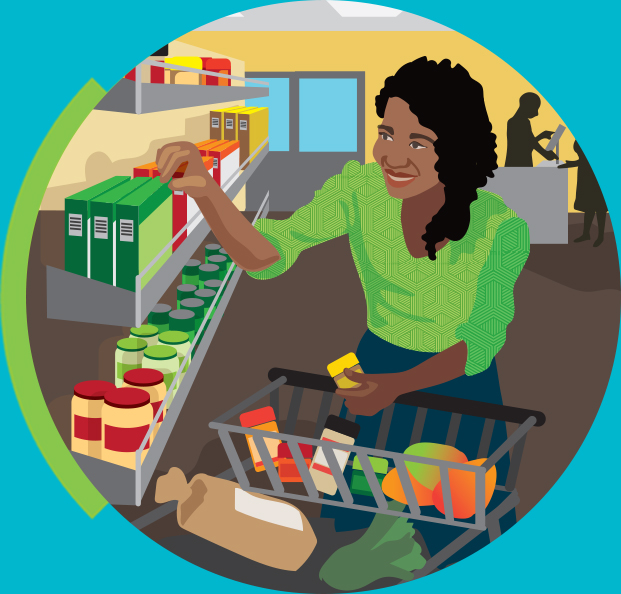Consumers have significant influence over the direction of the food and agriculture system. Through their purchases they express their preferences and values and help shape the decisions producers and retailers make.
Their influence is growing as they consider what they buy, why they buy it and how and where they purchase food and agriculture products.1
These consumer trends are global, but the nature and extent of their influence is shaped by geography, cultural norms, government policy and socio-economic status. The following chapter provides an overview of these global drivers of change. An in-depth look at the evolution of U.S. consumer preferences shows how these trends are transforming food and agriculture systems in the twenty-first century.


Demographic Drivers of Change
Food demand is driven largely by changes in the size, rate of growth and age of the population. Even though the rate of global population has slowed, by 2050 there will be nearly 10 billion people needing nutritious, safe affordable food.2 The latest UN Population Report finds that the global population is growing older and younger, with significant implications for global food demand.
Global birthrates are declining and in a growing number of countries, the birthrate is too low to maintain the current population levels. At the same time, life expectancies are rising, even in low-income countries. As a result, in 2050 the number of people aged 60 and over will equal the number of people aged 15 and under.3
As people age, they do not need to eat as much, which may slow the overall rate of food demand growth in coming decades. Seniors are living longer than they anticipated and without employment or sufficient savings, increased rates of food insecurity and undernutrition among seniors are likely. Many will need government and non-profit food assistance programs to meet their basic nutritional needs.
By contrast, the population in some regions is trending younger. In sub-Saharan African, 60 percent of the population is under 25 years of age and the birthrate, while declining, is still twice the global average.4 This youth explosion is driving up food demand, but many of these young people are living at or below the poverty line. They lack the resources to purchase or grow enough nutritious food to maintain a healthy diet.
Finding any food at all is a daily struggle for 810 million people and 151 million children are affected by stunting (low height-for-age ratio) which causes life-long physical and cognitive impairments.5 At the same time, overweight and obesity rates are rising to alarming levels, especially among the young; 38 million children are now overweight or obese.6
 With Money to Spend, Consumers Prioritize Food Diversity, Nutrition and Safety
With Money to Spend, Consumers Prioritize Food Diversity, Nutrition and Safety
The number of people actively involved in food production continues to decline, yet consumer interest in the content and origins of their food increasingly drives their purchases.
Healthy diets are a top priority, especially for women who make most of the household food purchases, but what comprises a healthy diet is a source of ongoing discussion and uncertainty. Consumers report that the proliferation of food information and opinion makes it difficult for them to sort fact from fiction and identify which foods most closely meet their nutritional needs and social values.
Rising global incomes enable consumers to buy more high-value and imported foods, such fruits and vegetables, meat and packaged foods. New shopping venues are available for consumers as well. Supermarkets, long considered a phenomenon of developed economies, are popping up in unexpected places.
In sub-Saharan Africa, more people are purchasing food at supermarkets; the top five retail companies in Africa are South African-based supermarket chains.9
African consumers typically purchase food from small local shops and informal sellers. Supermarkets now compete directly by locating in urban centers, in and around lower and moderate-income neighborhoods.
In Nairobi, shoppers identified low prices and a large selection of items as the reasons they prefer supermarkets to smaller retail outlets.10 Urban consumers also see many of the premium food products offered by supermarkets as affordable luxury items, especially as the varieties of fruits, vegetables, meat, fish, spices and packaged items are not typically available in African markets.
Demand for premium products, even for staple foods, is also strong: 70 percent of the rice consumed in African cities is high-grade premium rice.11 While this growing demand for premium grocery products is currently met through imports, it also offers an enormous opportunity for African farmers and processors to profit and grow their businesses by expanding their productivity and capacity to deliver value-added foods.
 In China, rapidly rising incomes and the expanding middle class have spurred exponential growth in the consumption of poultry, pork and dairy.12 In response to domestic demand, China’s imports of fresh and chilled pork increased from 136,000 metric tons in 2000 to 1.62 million metric tons in 2016.13
In China, rapidly rising incomes and the expanding middle class have spurred exponential growth in the consumption of poultry, pork and dairy.12 In response to domestic demand, China’s imports of fresh and chilled pork increased from 136,000 metric tons in 2000 to 1.62 million metric tons in 2016.13
Young urban consumers between the ages of 20-35shop at modern retail food stores and want to purchase more vegetables to improve their diets.
Chinese consumers are also more focused on nutrition, with more than 82 percent of people willing to pay more for foods they know are higher quality, more nourishing and lacking undesirable ingredients.14 This compares to the global average of 68 percent who are willing to pay for such foods.This shift towards healthy eating is being encouraged by the Chinese government. In 2017, the government launched its second 10-year healthy lifestyle campaign, urging consumers to eat less fat, salt and sugar and aim for “a healthy diet, healthy weight and healthy bones.”15
Consumers are also concerned about the safety of the foods they eat, particularly domestic rice and other food crops that may have been grown in contaminated farm soil. They are willing to pay more for trusted international brands that they know are high-quality and safe.
 United States: A New Consumer Shapes A New Century
United States: A New Consumer Shapes A New Century
In the U.S., food production and consumption are big business. According to the USDA Economic Research Service (ERS) U.S. consumers, businesses, and government entities spent $1.46 trillion on food and beverages in 2014.16 The agriculture and food sectors, from farm to fork, employ 19 million people in full and part-time jobs.17
American consumers are changing the way they engage with food, including how and where they buy it, as well as what they eat and why. Some of the factors driving these shifts include the rise of the Millennial Generation, the purchasing power of working women and concerns about diet and health.

Generational Shifts Drive Food System Change
By 2019, the Millennial Generation (aged 20-35) will surpass the Baby Boomers to become the largest generational group in the U.S. with 74 million people.18 Their numbers and purchasing preferences are beginning to fundamentally alter the food production and retail system in the U.S. and beyond.
Millennials, together with members of Generation X (66 million people, aged 36-51), are in their peak food-consumption years. Most are working and raising families and/or caring for elderly relatives. As a result, their food purchases are the trends most closely watched by producers, retailers and restaurateurs.
A USDA study of Millennial food purchases confirms that this generation spends more on food, overall, particularly on food not consumed at home.19 In their food-at-home purchases, they put a premium on convenience, spending just 55 minutes per day on food preparation and clean-up, significantly less than previous generations. Almost two-thirds of the Millennials surveyed said they bought some form of prepared food in the previous week.
Millennials shop for prepare-at-home-foods at a variety of retail outlets, rather than just their closest supermarket. They are also the biggest users of grocery delivery services and meal kits.
But it is their dramatic increase in food purchases from online-only retailers, such as Amazon.com, that has the greatest potential to disrupt the store-front grocery sector. A survey for the Food Marketing Institute (FMI) found that 43 percent of Millennials purchased food from online-only retailers during 2017, up from 28 percent in 2016.21 Baby food, pet food and treats, cleaning products, snacks and sweets are the most common purchases from online-only outlets; as delivery mechanisms for fresh and frozen items continue to improve, those purchases will increase as well.
The USDA study of Millennials provides an important nuance to the FMI survey findings.
Food expenditures and purchasing patterns within the Millennial generation differ depending on when people entered the work force, according to USDs data.22 Young people who tried to get their first jobs during the Great Recession struggled to find work and accepted jobs with lower wages. This leads to a lower wage growth trajectory that will continue throughout their working lives. As a result of their experiences, Recession Millennials have more conservative attitudes toward food spending. They eat at home more often and spend less on food compared to others in their generation, even those who have similar incomes, but started working before or after the recession.
While Recession Millennials are a relatively small segment of their generation, researchers predict that these conservative attitudes and spending habits will resonate throughout their lives.
 Women Are a Food Purchasing Powerhouse
Women Are a Food Purchasing Powerhouse
In most households around the world, women are the “chief purchasing officer” and have enormous influence over the food system.
Women are responsible for 85 percent of all consumer spending in the U.S., with an estimated annual purchasing power ranging from $7 trillion to $15 trillion.23 In a 2017 survey of U.S. consumers, 90 percent of women said they are the primary shoppers in their households.
Many women are also the primary earners in their families. In 40 percent of households with children under the age of 18, women are the main breadwinners.24
Marketing surveys consistently find these working moms prioritize health, convenience and price in their food choices, both at grocery stores and in their restaurant purchases. Grocery stores offer family-sized prepared meals that allow women to choose the combination of dishes her family wants and needs.
 The quick-serve restaurant industry is responding to women’s preferences by offering healthier options that are lower in fat, calories, carbohydrates, sugar and salt.25Assembly-line style ordering allows women to choose the ingredients that suit their tastes and needs.
The quick-serve restaurant industry is responding to women’s preferences by offering healthier options that are lower in fat, calories, carbohydrates, sugar and salt.25Assembly-line style ordering allows women to choose the ingredients that suit their tastes and needs.
While these options are costlier than food prepared at home, women also consider the value of their time in their purchasing calculus.
 Nutrition is Always in Season
Nutrition is Always in Season
New data from the U.S. Centers for Disease Control and Prevention show that in 2017, seven states had obesity rates of at least 35 percent, the highest being West Virginia at 38.1 percent.26 The trend over the past five years is troubling, as in 2012, no state exceeded 35 percent.
The need to manage weight and cardiovascular health is a growing consumer concern; these were the top reasons given for following a specific diet. More than one-third of Americans followed a specific eating pattern or diet in the last year, according to an annual survey by the International Food Information Council (IFIC).27 Consumers said that reducing the consumption of sugars and carbohydrates is important for health and they prefer foods without artificial ingredients.
Sales of fruits and vegetables and fresh meat are increasing, while the companies that produce the traditional cereals, snacks, soups and condiments that populate the middle aisles of the grocery store are seeing their unit sales decline.28
The supply of fresh fruits and vegetables available to U.S. consumers has risen dramatically in the last 25 years. In Michigan State University’s (MSU) Food Literacy and Engagement Poll, 78 percent of consumers reported that they could access to fresh fruits and vegetables every day of the week.29
The increased availability of fresh produce has coincided with the implementation of the North American Free Trade Agreement (NAFTA), which eliminated nearly all tariffs on agricultural products and harmonized food safety standards between the U.S., Mexico and Canada. As a result, U.S. consumers can purchase a wide variety of fresh produce, even if it is out-of-season or not grown in their region.30

More Strawberries, but Higher Prices
One of the most popular products with U.S. consumers are berries (strawberries, raspberries, blueberries and blackberries) from Mexico which can be purchased year-round at most grocery stores in the country.
The annual supply of fresh strawberries available for U.S. consumers has increased from 810 million pounds in 1990 to 2.6 billion pounds in 201631 (Figure 1). Annual per capita consumption of strawberries quadrupled from 2 to 8 pounds during that time.32
Even though the supply of fresh strawberries has tripled in the last 25 years, the explosion of consumer demand has kept retail prices high, from $1.40 per pound in 1990 to $3.99 in 201633 (Figure X1). The same is true for fresh fruit prices across the board (Figure X2). The Consumer Price Index shows that prices for fresh fruit have tripled from 1990-2016. By contrast, prices for frozen and processed fruit products have remained relatively stable.
View Full ChartFigure 1

Source: USDA ERS. Annual Fruit and Tree Nut Book (2018)
Figure 2

Source: USDA ERS. Annual Fruit and Tree Nut Book (2018)
The increase in per capita consumption of fresh fruit and vegetables represents progress towards healthier, more diverse diets. Yet, dietary data from the US Departments of Agriculture and Health and Human Services (HHS) indicate that only children under the age of 8 are eating the recommended daily amount of fruit, and no age or gender group is consuming the recommended amount of vegetables.34
The continued upward trend in prices for fresh fruits and vegetables could be preventing low and middle-income consumers from purchasing them. Encouraging consumption of frozen produce, which has the same nutritional content as fresh produce, could help more consumers meet the daily recommended intake levels.
View Full Chart Information Overload Creates Uncertainty in the Food System
Information Overload Creates Uncertainty in the Food System
Even with the trends towards foods that are healthy, convenient and sustainably sourced, consumers consistently rank taste, price and brand familiarity as their top considerations when purchasing food.42
Consumers are aware of the general principles of nutrition, but many say they are uncertain about which foods and nutrients would help them achieve their dietary goals. Eighty percent of consumers in the International Food Information Council (IFIC) 2018 Food and Health Survey said there is conflicting information about what they should eat or avoid; 59 percent said this confusion makes them doubt their food choices.43
Consumers are bombarded with food-related information and opinion in the news media, on the internet and through social media. Identifying authoritative, trustworthy sources can be difficult. This creates inconsistencies between what consumers say they want and what they purchase when they get to the store.
MSU’s Food Literacy and Engagement Poll captures some of this consumer uncertainty.44 A plurality of consumers (38 percent) say that have a higher than average understanding of the global food system, but a plurality also said that they aren’t sure how many times a week they consume foods containing genetically modified ingredients. Fifty-one percent of consumers say they would be willing to pay more for food items that had a less damaging impact on the environment (although the survey does not indicate how much more), but 48 percent said they rarely or never seek information about how their food was produced.
In the survey, 66 percent said that food labels are very influential in their food choices but given the uncertainty about what is in their food and how it was produced, the labeling systems are not providing the clarity they need. In lieu of trustworthy, accessible information, consumers fall back on the familiar: taste, price and brands they know and trust.

Misinformation about food production methods has very real consequences for human health. A study of low-income shoppers found they were wary of purchasing conventionally-produced fruits and vegetables for safety reasons. This inaccurate information about the levels and health impacts of pesticide residues on produce has been shared widely on social media. As a result, low-income consumers said they were less likely to buy conventional produce and would prefer to purchase smaller quantities of the more expensive organic varieties.
Low-income consumers already purchase fewer fresh fruits and vegetables and have higher obesity rates than people with higher incomes. If these price-constrained consumers purchase even less produce due to confusion about pesticide residues, this hinders their ability to improve their health through nutritious diets.




